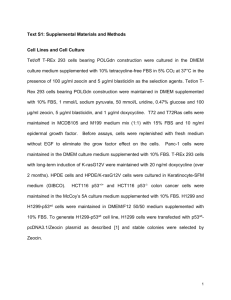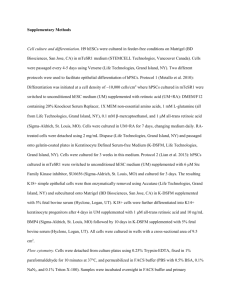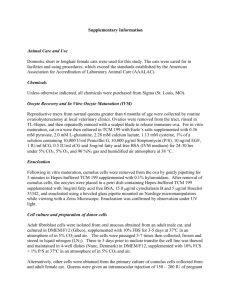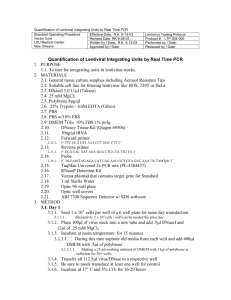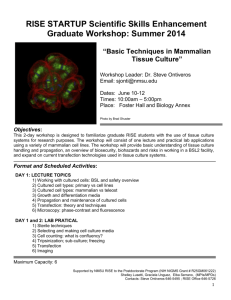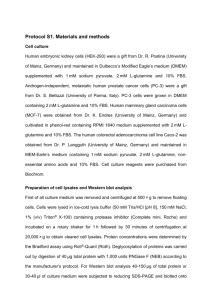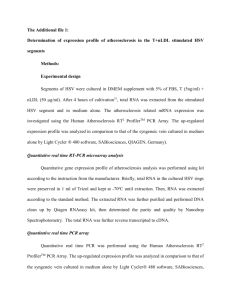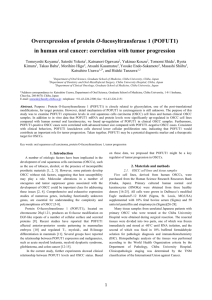mc22297-sup-0001-SuppData-S1
advertisement
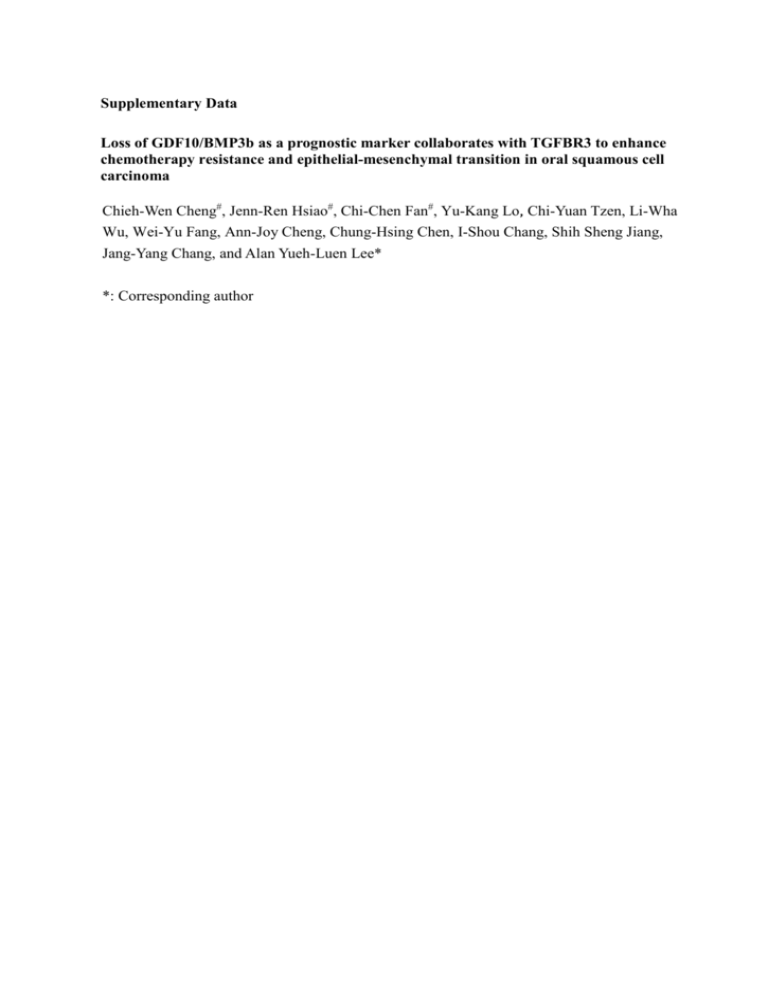
Supplementary Data Loss of GDF10/BMP3b as a prognostic marker collaborates with TGFBR3 to enhance chemotherapy resistance and epithelial-mesenchymal transition in oral squamous cell carcinoma Chieh-Wen Cheng#, Jenn-Ren Hsiao#, Chi-Chen Fan#, Yu-Kang Lo, Chi-Yuan Tzen, Li-Wha Wu, Wei-Yu Fang, Ann-Joy Cheng, Chung-Hsing Chen, I-Shou Chang, Shih Sheng Jiang, Jang-Yang Chang, and Alan Yueh-Luen Lee* *: Corresponding author Supplementary Materials and Methods Cell culture HSC-3, FADU, and KB cells were cultured in medium containing Dulbecco’s modified Eagle’s essential medium (DMEM), supplemented with 5% fetal bovine serum (FBS) and 5% super calf serum. The all medium contain penicillin 100 Units/mL, streptomycin 100 μg/mL except mentioned. SCC-4, SCC-9, SCC-15, SCC-25, and SAS cells were cultured in medium containing a 1:1 mixture of DMEM/F12 medium, supplemented with 10% FBS. OC3 cells was cultured in medium containing a 1:1 mixture of DMEM/K-SFM medium, supplemented with 10% FBS and OEC-M1 and YD-15 cells were cultured in medium containing RPMI 1640 medium, supplemented with 10% FBS. Oral pre-cancer lesion cell DOK (dysplastic oral keratinocyte) was cultured in medium containing DMEM, supplemented with 10% FBS . Oral keratinocyte normal cell lines, CGHNK2 and CGK6 , were grown in a culture medium containing K-SFM medium, supplements for K-SFM, supplemented with G418 (400 μg/mL). Whole cell lysate The cell lysate preparation was performed as described previously [39]. Cells were lysed in NETN (150 mM NaCl, 1 mM EDTA, 20 mM Tris-Cl pH 8.0, 0.5% NP-40 (v/v)) containing protease and phosphatase inhibitors (50 mM sodium fluoride, NaF, 0.1 mM sodium orthovanadate, NaVO4). Western blot analysis The cells were harvested by trypsinization and lysed with NETN buffer (20 mM Tris (pH 8.0), 1 mM EDTA, 150 mM NaCl, 0.5 % Nonidet P-40 (NP-40)) containing protease inhibitor cocktail (Roche). The cell lysates were then centrifuged at 10,000 g at 4°C to obtain solubilized cellular proteins. Protein was quantified with a bicinchoninic acid (BCA) protein assay (Pierce, Rockford, IL) according to the manufacturer’s instructions. Proteins were separated by 8% or 10% or 12% SDS-PAGE and electrotransfered to a polyvinylidene fluoride membrane. Blots were probed with primary antibodies, followed by HRP-conjugated goat anti-rabbit IgG (1: 5000, v/v) (Zymed, South San Francisco, CA, U.S.A.) or HRP-conjugated goat anti-mouse IgG (1:5000, v/v) (Zymed, South San Francisco, CA, U.S.A.). After washing with PBS containing 0.5% Tween-20, peroxidase activity was assessed using enhanced chemiluminescence (PerkinElmer Life Science, Boston, MA, U.S.A.). The intensities of the reaction bands were analyzed with the Image Gauge System (Fuji, Tokyo, Japan). Reverse transcription-polymerase chain reaction (RT-PCR) Total RNA was extracted using Trizol reagent (Invitrogen, Carlsbad, CA) and reverse-transcribed at 37C with SuperScript II reverse transcriptase (Invitrogen). The resulting cDNA was used as the template for PCR reactions. Real-time PCR (qPCR) reactions were performed on a RotorGene 3000 system (Corbett Research, Mortlake, Australia) using SYBR Green PCR Master Mix (Cambrex Co., East Rutherford, NJ). The sets of forward and reverse primers, the corresponding PCR conditions, and the lengths of PCR products were described as follows: GDF10 [5’-TGCTATGCAACAGATAAAGTTTGTAG-3’, 5’-TCCTGGTGTACCTGCCCTA-3’; 94C (30 sec), 60C (60 sec) and 72C (30 sec) for 40 cycles, 72 bp]; glyceraldehyde 3-phosphate dehydrogenase (GAPDH) [5’-GAAGGTGAAGGTCGGAGT-3’, 5’-GAAGAT GGTGATGGGATTTC-3’; 94C (30 sec), 52C (30 sec) and 72C (1 min) for 28 cycles, 220 bp]. All the PCR reactions were started at 94C for 5 min and terminated at 72C for 5 min. Finally, the data were analyzed using RotorGene software v5.0 (Corbett Research). Differential RNA expressions between various samples were calculated using GAPDH as an internal control. Table S1. Clinicopathological characteristics in OSCC patients (n=122) Variables Number of patients (%) Age (years) 62 62 Gender Female Male Alcohol drinking No Yes Betel quid chewing No Yes Cigarette smoking No Yes Differentiation Well / Moderate Poor Tumor Size 2 cm 2 cm Lymph node metastasis No Yes TNM stage* In situ I II III IV Treatment None RT CT CT+RT 68 (55.7) 54 (44.3) 7 (5.7) 115 (94.3) 38 (31.1) 84 (68.9) 90 (73.8) 32 (26.2) 55 (45.1) 67 (54.9) 109 (89.3) 13 (10.7) 69 (56.6) 53 (43.4) 104 (85.2) 18 (14.8) 3 (2.5) 13 (10.8) 8 (6.7) 10 (8.3) 86 (71.7) 6 25 48 43 (4.9) (20.5) (39.3) (35.2) Recurrence No Yes Death No Yes 80 (65.6) 42 (34.4) 60 (49.2) 62 (50.8) *There are two patients who have no information of stage were excluded. Table S2. Association of GDF10 expression with clinicopathological tumor characteristics in OSCC patients (n=122) Variables Gdf10 High Low P-value 7 8 61 46 0.633 1 6 1 14 101 6 9 32 75 0.622 13 2 77 30 0.369 7 8 48 59 1 12 3 97 10 0.420 13 2 56 51 0.025 14 1 90 17 0.579 21 84 1 II 3 12 Treatment None RT CT CT+RT 2 1 6 6 4 24 42 37 0.244 Age (years old) 62 62 Gender Female Male Alcohol drinking No Yes Betel quid chewing No Yes Cigarette smoking No Yes Differentiation Well / Moderate Poor Tumor Size 2 cm 2 cm Lymph node metastasis No Yes TNM stage* II Recurrence No Yes Death No Yes Patient number 13 2 67 40 0.122 7 8 53 54 1 15 107 Table S3. Association of GDF10 expression with clinicopathological tumor characteristics in OSCC patients (n=62) Variables Gdf10 High Low P-value 4 4 27 27 1 0 3 1 8 51 3 5 15 39 0.882 7 1 36 18 0.434 2 6 21 33 0.714 6 2 47 7 0.716 7 1 23 31 0.046 8 0 41 13 0.273 1 7 8 46 1 8 54 Age (years old) 62 62 Gender Female Male Alcohol drinking No Yes Betel quid chewing No Yes Cigarette smoking No Yes Differentiation Well / Moderate Poor Tumor Size 2 cm 2 cm Lymph node metastasis No Yes TNM stage* II II Patient number Supplementary Figure 1. Immunohistochemical analysis of GDF10 expression in OSCC patients. Representative immunohistochemical staining of GDF10 was performed by using paraffin-embedded sections of OSCC and benign epithelium. The representative intensity of immunostaining was classified as four levels: negative staining intensity (0) and positive staining intensity, including weak (1 +), moderate (2 +), and strong (3 +) staining. Microscopic magnification, ×400. Supplementary Figure 2. Level of GDF10 afects cell growth, cell cycle progression and the sensitivity to DNA-damaging agent (A) Overexpression of GDF10 induces cell cycle arrest and decreases cell growth. 2 x 105 of OEC-M1 and OEC-M1/GDF10 cells were seeded. After 24, 48 and 72 hours, cell number was analyzed by counting. **, p <0.01; ***, p <0.001. (B) Knockdown of GDF10 increase the CPT sensitivity of SCC-9 cell line. SCC-9 or shGD10 SCC-9cells were cultured in 96-well plates (1 × 104 cells/well) in triplicate and then followed by treatment of increasing amount of CPT. After 1 day incubation, cell viability was determined as described in Materials and Methods. Supplementary Figure 3. The expression pattern of GDF10/BMP3b and TGFBR3 in oral cancer cell lines. The extracts of oral cancer cells were immunoblotted with an antibody to GDF10 and TGFBR3, and antibody to GAPDH as a loading control.

